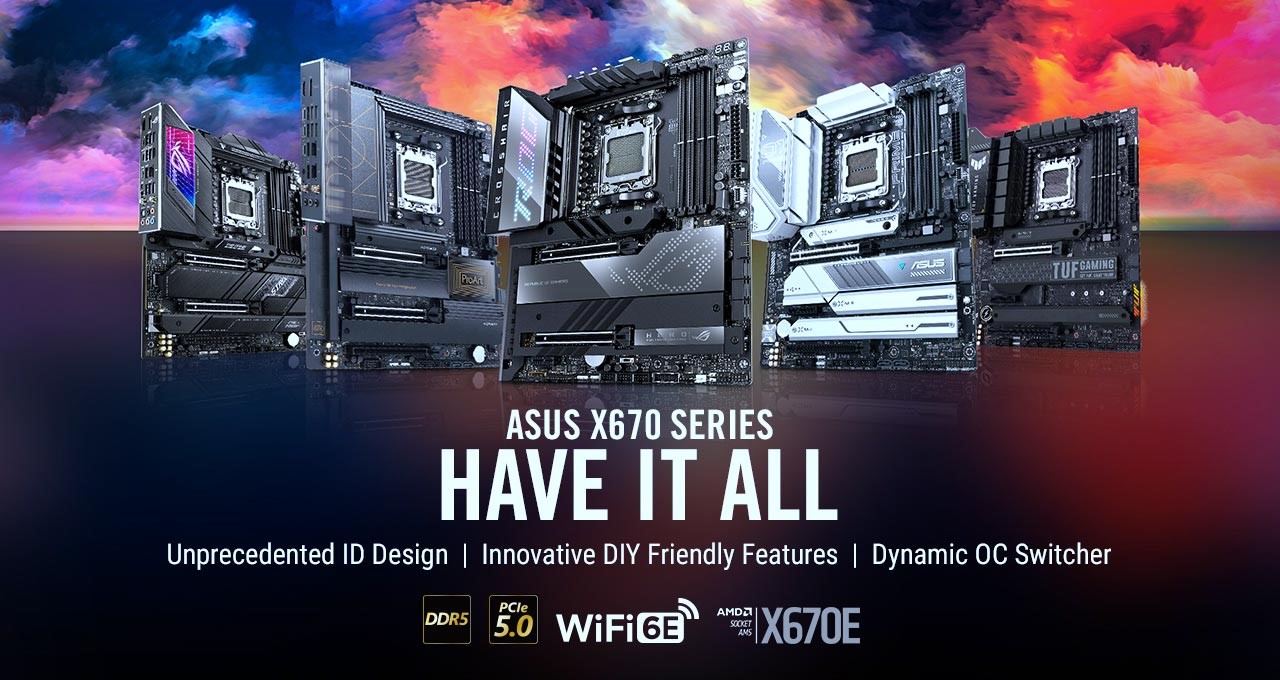ASUS has announced a full lineup of AMD X670-based motherboards ― a collection that includes the ROG Crosshair, ROG Strix, TUF Gaming, ProArt and Prime series.
Three generations of AMD Ryzen™ processors have won over gamers, professional users and creators alike. Packed to the brim with cores, these chips excel at tasks that call for an extra dose of parallel computing power, like heavy multitasking, 3D modeling and video rendering, or livestreaming game sessions on Twitch. Now, AMD has fired off its fourth salvo of AMD Ryzen CPUs — and ASUS has the X670E and X670 motherboards that can harness the full potential of these new chips.
“ASUS is making a statement with its five distinct series of X670 motherboards, offering users an enormous range of options that pair perfectly with AMD Ryzen 7000 Series processors,”
“With a host of unique and exclusive features, users will be able to unlock the full potential of the AM5 platform with the latest DDR5 and PCIe 5.0 connectivity.”
David McAfee – Corporate Vice President and General Manager, Client Channel Business Unit, AMD
This X670E and X670 motherboard lineup has something for everyone. The ROG Crosshair series returns to offer uncompromising performance and style for those who dare to build a gaming PC like none other. ROG Strix boards deliver gaming prowess in a wide range of designs, while the TUF Gaming lineup delivers essential features in a battle-hardened design. The ProArt X670E-Creator WiFi serves the creative community with its professional style, exceptional connectivity, and powerful performance. Finally, ASUS has expanded the value-focused Prime motherboard lineup with options that provide an accessible entry point to X670E and X670 for builders of all stripes.
Raised To The Power Of Five
Key changes to AMD’s CPUs and chipset enable ASUS to make X670 a truly next-gen platform. Fabricated on a cutting-edge 5-nanometer process, AMD Ryzen 7000 Series processors slot into the all-new AM5 socket. As an LGA-style socket, the pins are on the motherboard, not the CPU, making any accidental bending or damage to the pins less likely. AM5 supports up to a 170 watts of thermal design power (TDP), enabling exceptional compute performance for high-core-count CPUs in heavy workloads.
But it is not just the CPU socket that enjoys a next-gen upgrade. X670E and X670 motherboards support the latest DDR5 RAM. With data rates 50% faster than previous-generation DDR4 memory, DDR5 unleashes a new tier of performance, and ASUS motherboards offer a host of hardware and firmware optimizations that enable users to overclock capable kits to the absolute limit.
X670E and X670 motherboards also boast PCIe® 5.0 connectivity. With double the link speeds of PCIe 4.0, the new standard provides the bandwidth to deck out ASUS X670E and X670 motherboards with a comprehensive selection of high-speed ports. There are models equipped with the latest USB4® ports, and USB 3.2 Gen 2×2 ports abound across the lineup.
X670E and X670 boards differ in their deployment of PCIe 5.0 and PCIe 4.0 across the circuitry. The ‘E’ in X670E stands for Extreme. It ensures that users are getting a board decked out with a PCIe 5.0 x16 slot and at least one PCIe 5.0 M.2 socket. But ASUS is not content to just provide the minimum — if high-speed storage is the goal, users will find it in abundance in the top-tier offerings. Most ROG Strix X670E boards have at least two onboard PCIe 5.0 M.2 slots, and the flagship ROG Crosshair X670E Extreme offers a total of four PCIe 5.0 slots between its onboard slots and bundled add-in cards. Since higher-end and larger-capacity M.2 SSDs can produce more heat, ASUS is also upping its cooling game for X670E and X670. Many of these M.2 slots include a dual-sided M.2 heatsink to aid in heat dissipation.
Hassle-free PC Building
It has been decades since building a PC required a computer science degree, and ASUS works tirelessly to make PC DIY easier with each generation of motherboards. Exclusive ASUS Q-Design innovations across the X670E and X670 lineup simplify and streamline the process of building and upgrading a PC.
Today’s cutting-edge graphics cards often have beefy cooling solutions and sturdy backplates. That is great for performance — but they can get in the way of popping the PCIe release latch free. The ASUS PCIe Slot Q-Release button lets users release their graphics card from the slot with one press. Users will find this convenient feature on all ROG Crosshair X670E motherboards, the ProArt X670E-Creator WiFI, most ROG Strix options and even the Prime X670E-Pro.
Similarly, traditional DIMM slot designs require users to lock in both sides of the memory stick, and it was not always easy for those with larger fingers to unlock the latch closest to the graphics card. That is why ASUS has also implemented its single-sided Q-DIMM latching design on all X670E motherboards. With this arrangement, users will not have to worry about a latch that may be too close to their graphics card. A single latch on the easier-to-access side of the DIMM slot is all it takes to hold a memory stick firmly in place. Installing RAM — and upgrading it down the road — is now much easier.
ASUS has even simplified the process of installing an M.2 drive. The exclusive M.2 Q-Latch means users will never have to handle another tiny, easily lost M.2 screw; now they can secure or loosen an M.2 drive with just their fingertips.
A New Generation of Cool
Many builders these days opt for higher-RPM case fans capable of moving large volumes of air. These fans are just the ticket for keeping high-performance components cool under load, but they can produce excessive noise when users are performing light tasks like web browsing or emailing. To give users an easy tool for getting effective airflow under load and quiet operation during light tasks, ASUS is debuting AI Cooling II for its entire X670E and X670 motherboard lineup.
When enabled via the FanXpert interface in the Armoury Crate app, the tool employs a machine-learning algorithm to gather system data during a brief stress test. From then on, AI Cooling II monitors the CPU and uses the data from the stress test to calculate the lowest fan speed required to effectively cool the system — while keeping noise levels low. This fan control system can reduce system fan noise by up to 5.7 dB under sustained loads. Through this self-adaptive system, users will always have cooling power when they need it and quiet operation when they want it. ASUS has also taken the opportunity to update FanXpert with its full set of fan calibration and control options. Temperature input mapping and fan response mapping are both available within Windows through the convenient Armoury Crate app.
Powerful Tools for Power Users
The first thing that many hardware enthusiasts will do with their new AMD Ryzen 7000 Series processors and X670E motherboard is see just how much extra performance they can coax out of their system through overclocking. In heavily threaded workloads, an all-core manual overclock can offer substantial benefits. But for more lightly threaded applications like gaming, AMD’s built-in Precision Boost Overdrive (PBO) is often the superior choice. This performance-maximizing tech automatically analyzes factors such as CPU temperature, number of actives tasks and power consumption to intelligently raise clock speeds.
Users should not have to choose between PBO and manual all-core overclocks. That is why ASUS developed the Dynamic OC Switcher. This feature debuted in the legendary last-gen ROG Crosshair VIII Dark Hero motherboard, and now ASUS is including the necessary onboard microcontroller on all its X670E motherboards. This feature automatically flips between the two modes to provide the best performance for the task at hand. After configuring a manual overclock for heavy tasks, users can select a threshold for the Dynamic OC Switcher to activate, based on amperage and temperature. From that point, the system will operate with PBO by default, but it will kick over to a manual overclock dynamically for exceptional multithreaded performance exactly when it is needed the most.
Users can also leverage the new Core Flex feature to smash limits through discrete control of clocks, power delivery and thermals. In its simplest form, users can maximize the base clock during lighter loads and set breakpoints to gradually reduce CPU core frequencies as temperature or current increases. This system is extremely adaptable, supporting multiple settings to manipulate power, current, and temperature limits independently so that users can bend CPU performance to their will.
The ASUS X670E lineup also heralds the return of the ROG True Voltician. This oscilloscope kit, bundled with the ROG Crosshair X670E Extreme and the ROG Crosshair X670E Gene, streamlines the workflow of enthusiasts who need detailed analysis of the power circuitry on their motherboard to extract the highest levels of performance from their hardware. Once connected to the system, the oscilloscope system intuitively presents real-time voltage information on a separate system. It has never been easier to collect the data needed for professional-level overclocking.
ROG Crosshair Leads The Charge
Since 2006, ROG motherboards have relentlessly pushed the boundaries of design and performance to deliver true enthusiast-grade products for gamers who demand more. Using top-notch components and cutting-edge designs capable of hitting the highest speeds, ROG engineers create motherboards that exude quality and craftsmanship while redefining the possibilities of desktop computing.
A trio of ROG Crosshair X670E motherboards propel the series into the future with a next-gen feature set. The ROG Crosshair X670E Hero beckons with an unconquerable blend of enthusiast-grade features and sizzling style. The ROG Crosshair X670E Gene brings the high-end features of the new platform to mid-sized microATX builds. And atop the stack is the mighty ROG Crosshair X670E Extreme, an EATX motherboard built for those who want it all.
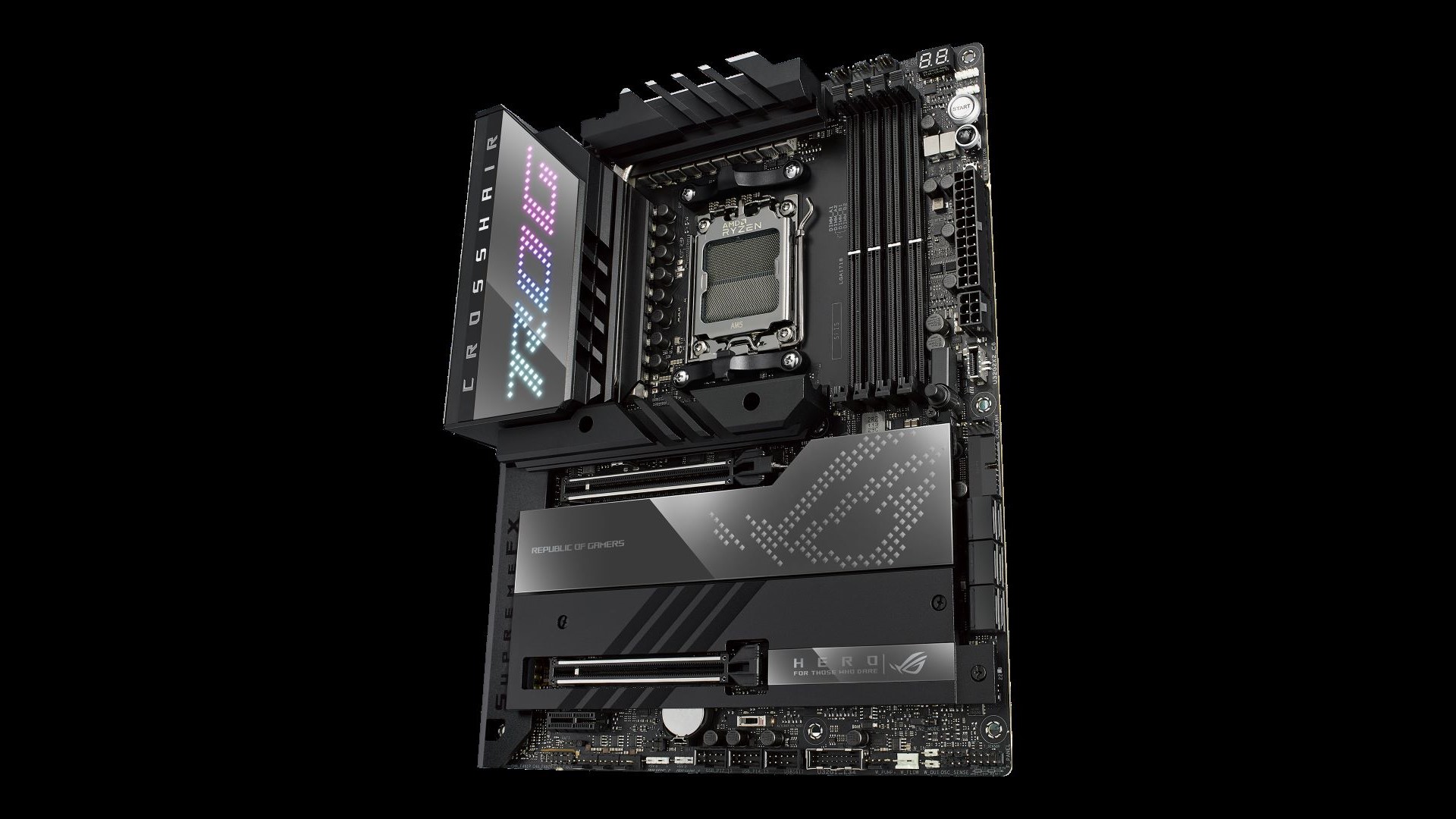
ROG Crosshair X670E Hero
As the most accessible model in the ROG Crosshair X670E lineup, the ROG Crosshair X670E Hero bridges the gap between professional PC builders and everyday gamers, allowing everyone to construct a high-performance showcase PC.
Dark hues predominate the surface of the ROG Crosshair X670E Hero, providing an intense backdrop for a build. Polymo lighting across the integrated I/O shield delivers a sizzling accent. This microstructural array of light and color features two RGB patterns, empowering builders to show off a luminous RGB style that they will not see anywhere else.
For those looking to take AMD Ryzen 7000 Series processors to the next level, its 18 + 2 teamed power stages rated for 110 amps can effortlessly deliver stable power to the CPU. Substantial integrated heatsinks keep the circuitry cool, and a wide array of headers let users set up a dream cooling solution.
The ROG Crosshair X670E Hero sets up users for a thoroughly next-gen gaming build. Its pair of PCIe 5.0 x16 slots stand ready for next-gen graphics cards, while also provide three PCIe 5.0 slots and two PCIe 4.0 slots. Pristine audio for competitive gaming and entertainment is provided with an audiophile-grade ESS® ES9218 Quad DAC that pumps top-notch sound to the front-panel output. With an exceptional signal-to-noise ratio, this audio solution is perfect for plugging in a high-quality headset.
High-end connectivity rounds out the Hero’s feature set. WiFi 6E lets users access the freshly opened 6 GHz band for unhindered wireless networking with compatible routers in select regions. Dual rear USB4 ports offer flexible access points for high-speed external storage and peripherals.
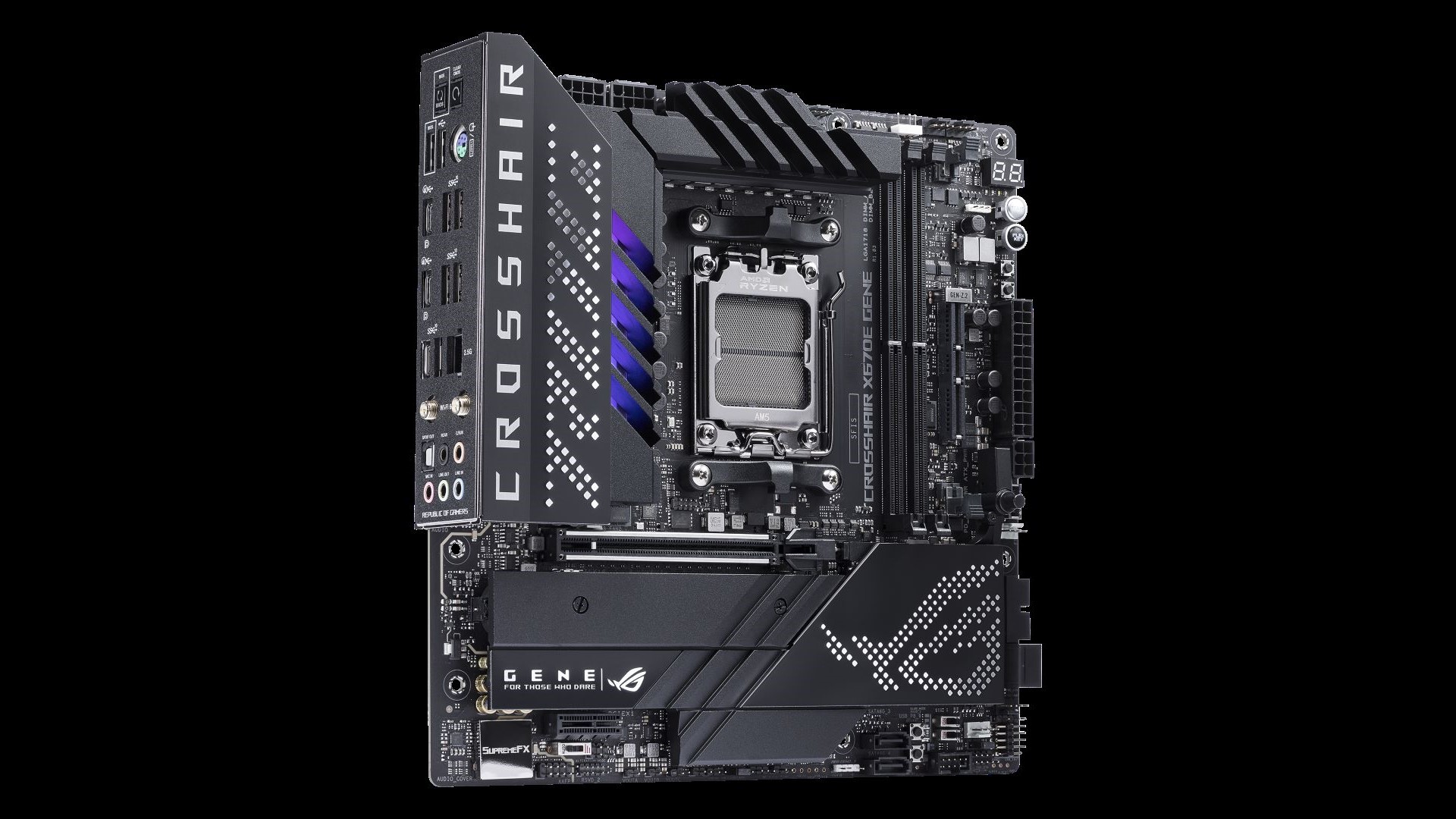
ROG Crosshair X670E Gene
One might say that microATX inhabits the Goldilocks zone of motherboard sizes — not too large, not too small. For gamers with no need for a second PCIe x16 slot, the ROG Crosshair X670E Gene delivers high-end performance, an exceptional feature set and the signature ROG aesthetic in the mid-size microATX form factor.
An engraved, reflective ROG logo on the integrated I/O shield and a pixelated Fearless Eye icon on the chipset heatsink herald allegiance to the Republic of Gamers. RGB LED accents on the VRM heatsink, customizable with Aura Sync, provide a splash of color on a board that otherwise makes a statement with its dark tones and angular accents.
The thoroughly next-gen X670 platform lets users take gaming experiences to the power of five with PCIe 5.0 and DDR5. Its PCIe 5.0 x16 slot can handle the fastest graphics of today and tomorrow, and its support for DDR5 lets users enjoy the massive bandwidth, sizzling new speeds, and exceptional power efficiency offered by next-generation DDR5 RAM. Between its onboard slots and the ROG Gen-Z.2 card, the Gene offers two PCIe 5.0 M.2 slots and one PCIe 4.0 M.2 slot, giving ample elbow room to build out a fast and spacious game library — and expand it down the road. And, of course, this motherboard is built for even the mightiest AMD Ryzen 7000 Series processors with its robust power solution with 16 + 2 teamed power stages rated for 110 amps.
The Gene’s wide suite of connectivity options checks all the boxes for a top-tier motherboard: access to the freshly opened 6 GHz band through the latest WiFi 6E; Intel 2.5 Gbps Ethernet for unhindered networking; a pair of USB4 ports on the rear I/O; a connector for a front-panel USB 3.2 Gen 2×2 Type-C port; and support for Quick Charge 4+.
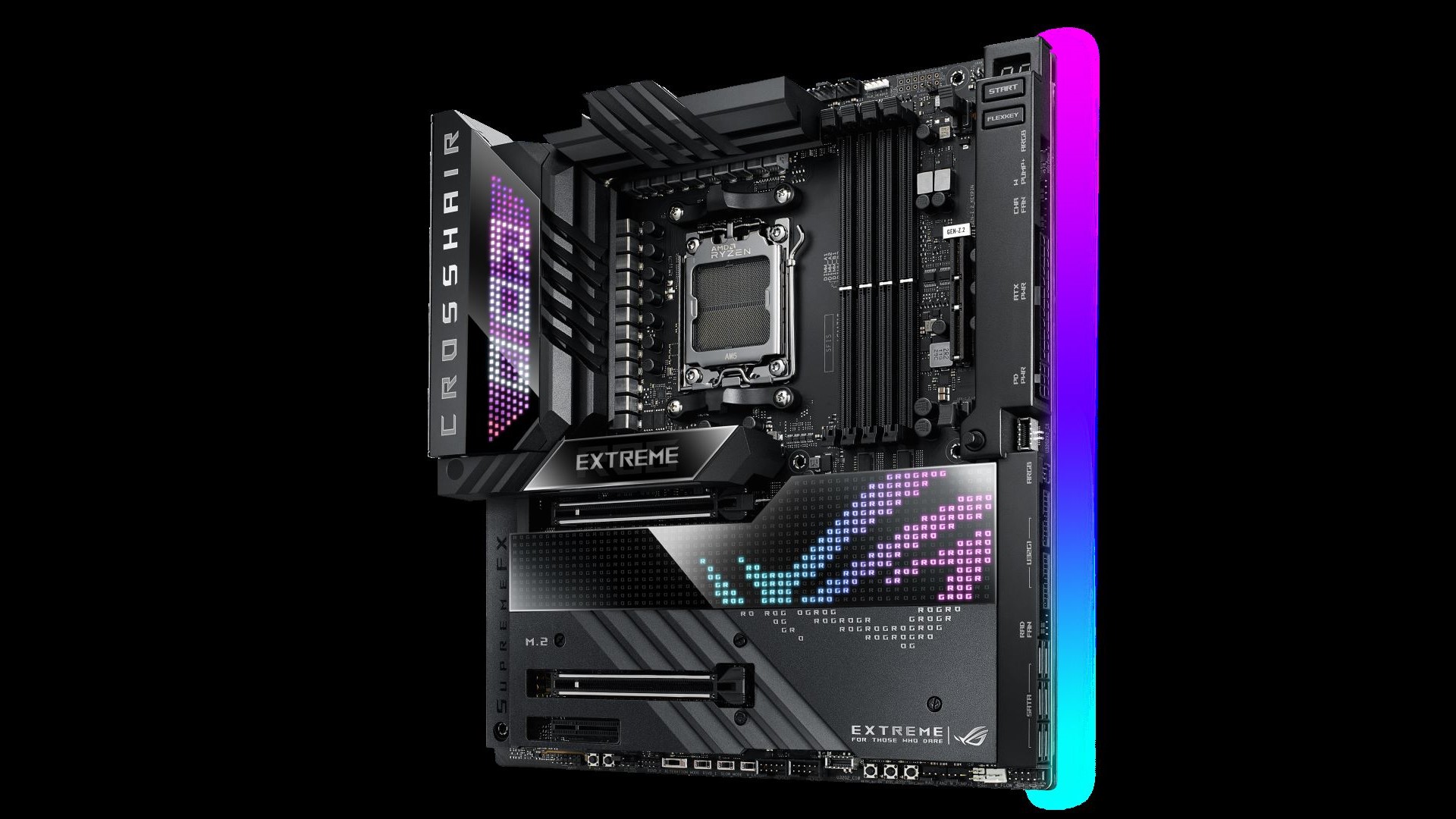
ROG Crosshair X670E Extreme
The ROG Crosshair X670E Extreme accepts no compromises and takes no prisoners. With its angular lines, vivid RGB LED accents, and moody black tones, the ROG Crosshair X670E Extreme motherboard loves taking center stage. For unmatched personalization options, this board features the AniMe Matrix™ display, an array of LEDs that can show off custom retro-style animations.
Time and again, the striking visual elements of the ROG Crosshair X670E Extreme serve the desire for unbridled performance. Large heatsinks atop the VRM circuitry, chipset and onboard M.2 slots offer substantial cooling power and symmetrical beauty. Multilayer graphics grace the surface of the wide heatsink cover for the primary M.2 slot. And the integrated aluminum I/O cover assists in cooling circuitry, simplifies the build process, and looks sharp in the process.
A robust power solution gives the ROG Crosshair X670E Extreme nearly unbounded potential for taking AMD Ryzen 7000 Series processors to the next level. With its 20 + 2 teamed power stages rated for 110 amps, this EATX motherboard is poised to deliver a stable stream of power to the CPU. Today’s processors take advantage of available power and thermal headroom to offer the best performance at any moment, so cooling is not just a matter of comfort — comprehensive cooling makes sure that users get the sustained performance that they demand. The ROG Crosshair X670E Extreme delivers a full suite of options for setting up a dream cooling solution. Six headers for chassis, radiator and CPU fans help establish and control system airflow. For those planning to deploy a custom liquid-cooling solution, a wealth of headers for pumps and flow rates brings total command over the coolant coursing through a build.
By doubling link speeds, the new PCIe 5.0 standard provides the bandwidth to deck out the ROG Crosshair X670E Extreme with USB4 and USB 3.2 Gen 2 ports. Since so many gamers use their PC’s front panel USB ports to recharge devices, the ROG Crosshair X670E Extreme offers a front panel USB 3.2 Gen 2 x2 connector with support for Quick Charge 4+. Pair this motherboard with a case featuring a front-panel USB Type-C port to have convenient access to 60-watt charging.[i]
Two PCIe 5.0 x16 slots are offered for the cutting-edge graphics cards of today and tomorrow. Between its two onboard slots and the three additional slots made available through the ROG PCIe 5.0 M.2 card and the ROG GEN-Z.2 card, the ROG Crosshair X670E Extreme offers five total M.2 slots ― four of which support PCIe 5.0 x4 mode. Heatsinks for all the slots, including those on the add-in cards, ensure the full performance of drives without throttling. Six SATA 6 Gbps ports establish an even larger storage array, so users never have to ration their game library.
The motherboard’s networking options are also impressive. WiFi 6E connectivity enables use of a compatible router in select regions to access the freshly opened, low-interference 6 GHz band. An Intel 2.5 Gbps Ethernet port delivers a high-bandwidth hardline to a router, while a Marvell AQtion 10 Gb Ethernet port preps a machine to easily handle multi-terabyte file transfers on fast networks.
If visuals take the front seat when it comes to gaming, audio rides shotgun. On the ROG Crosshair X670E Extreme, exceptional audio starts with a SupremeFX 7.1 Surround Sound audio solution with integrated amplifiers and op-amps. The audio circuit design uses premium capacitors, interference shielding and discrete traces for the left and right channels. Auto impedance detection allows even high-impedance audiophile headphones to get crystal-clear, distortion-free output. An ESS ES9218 Quad DAC pumps top-notch audio to the front-panel output with an exceptional 120 dB signal-to-noise ratio, ideal for high-end headsets.
ROG Strix Rallies Gamers Everywhere
For folks building a PC first and foremost for gaming, some of the exotic features of the ROG Crosshair series may feel more like luxuries than necessities. ROG Strix motherboards retain key elements of the style and performance of the Crosshair series while avoiding specialized features that everyday builders might not need. In total, ASUS is offering four ROG Strix X670E motherboards: a trio of high-performance ATX motherboards with varying levels of features and styles, and a Mini-ITX marvel in the ROG Strix X670E-I.
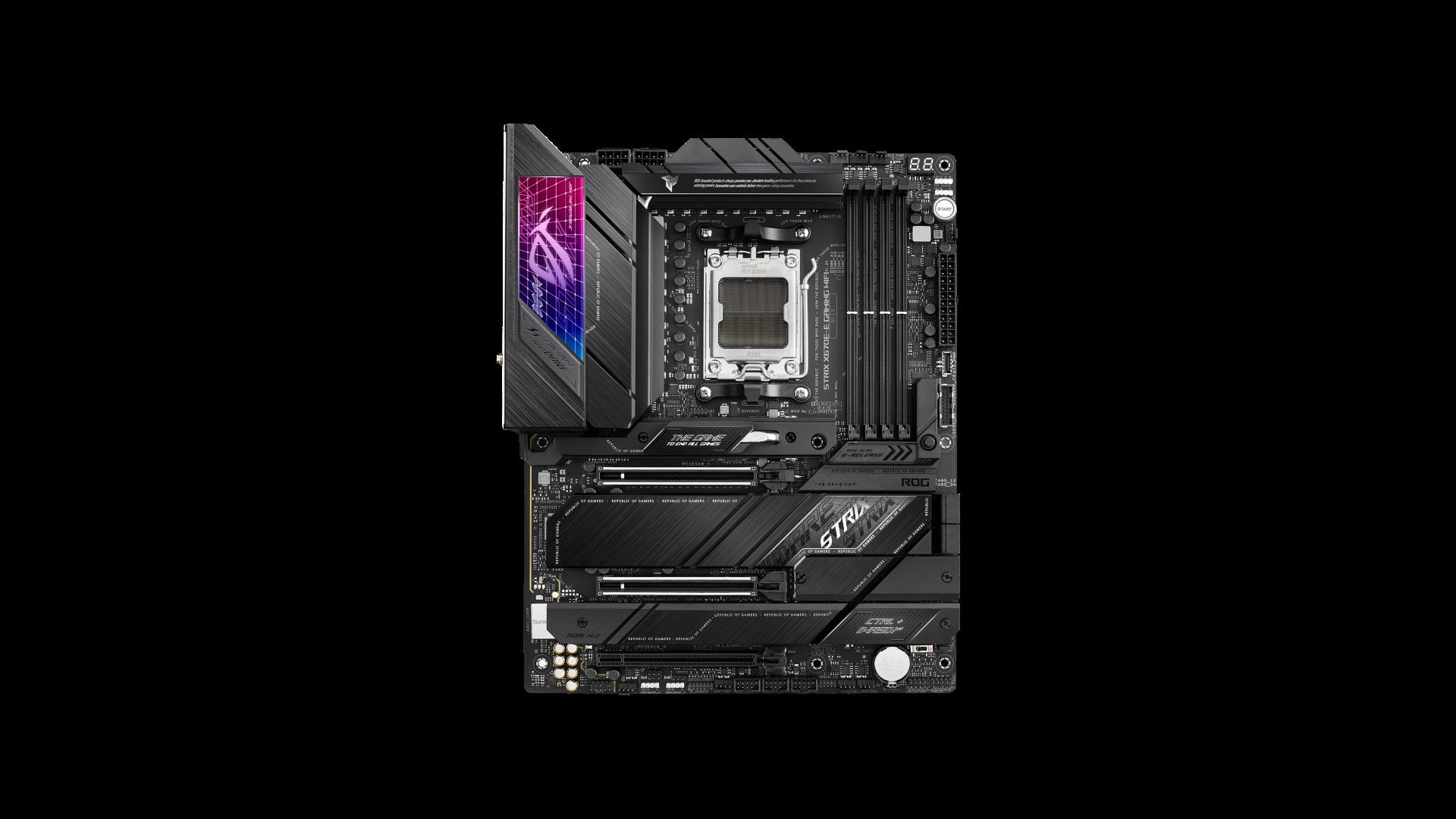
ROG Strix X670E-E Gaming WiFi
As the highest-performance board of the Strix family, the ROG Strix X670E-E Gaming WiFi merges the best of form and function. Angular accents sweep across the board’s heatsinks alongside distinctive ROG iconography, while an illuminated acrylic display on the integrated I/O cover makes an impactful statement.
Comprehensive power and thermal solutions set users up to tame the latest high-end gear. 18 + 2 teamed power stages rated for 110 amps deliver a stable stream of power to an AMD CPU. Two PCIe 5.0 x16 slots await next-gen graphics cards and add-in cards. To keep PCIe 5.0 SSDs operating smoothly, the hefty and thick M.2 combo-sink provides a large surface area for cooling. And the massive M.2 heatsink is included in the accessory kit.
A new generation of conveniences ease the building process with the ROG Strix X670E-E Gaming WiFi. In addition to the PCIe Slot Q-Release button, which makes it easy to remove the graphics card, there is an integrated start button on the motherboard that makes it easy to do a pre-test prior to building the whole system. And a spare M.2 thermal pad in the ROG accessory kit makes sure that users are able to keep future replacement drives operating optimally.
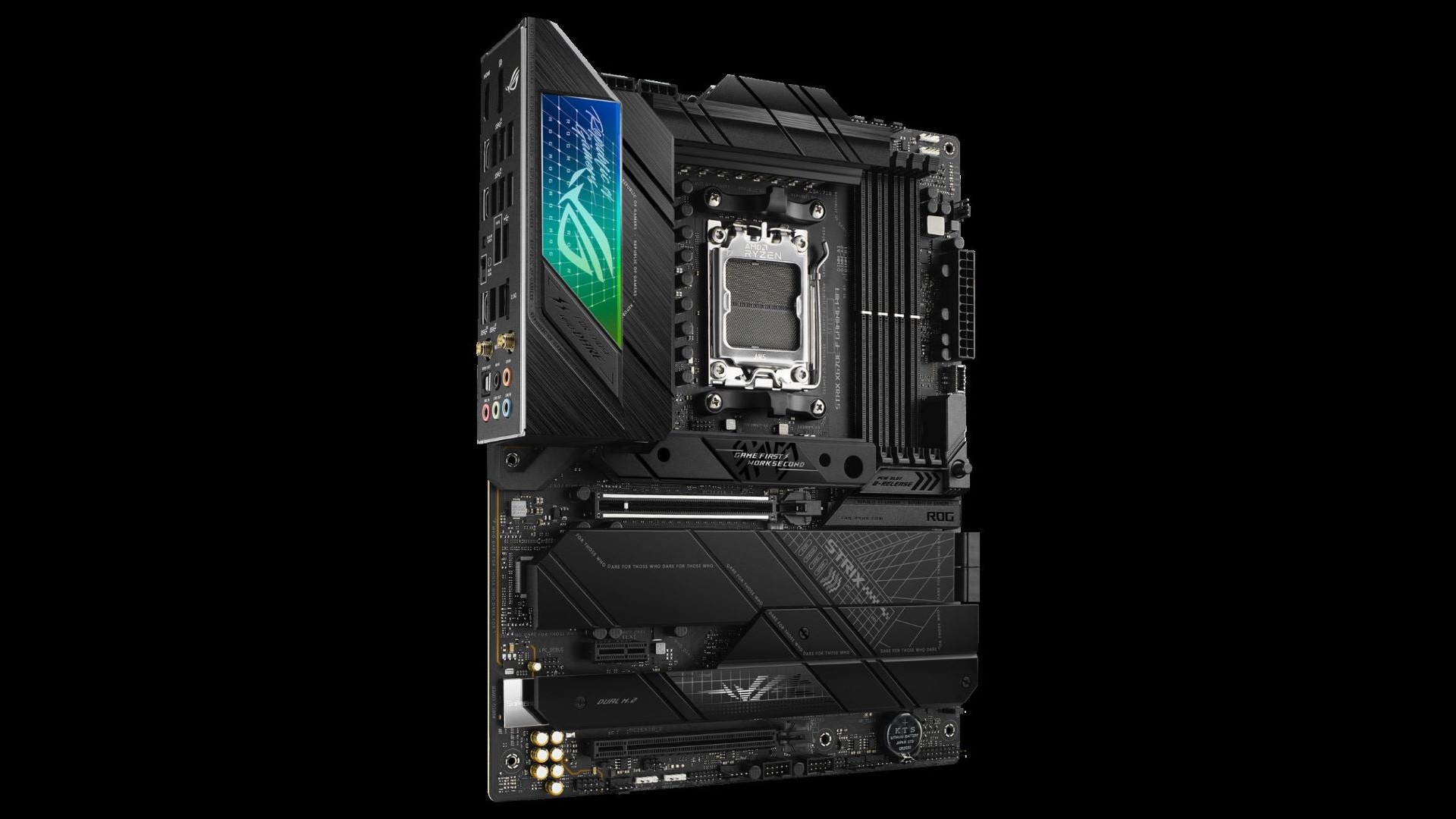
ROG Strix X670E-F / X670E-A Gaming WiFi
These days, many gamers only take advantage of one of the PCIe x16 slots on their motherboard. For them, the ROG Strix X670E-F Gaming WiFi and ROG Strix X670E-A Gaming WiFi offer everything they need for a high-end build in two striking and strikingly different styles.
These two motherboards share many of the same elements: one PCIe 5.0 x16 slot, four onboard M.2 slots (two wired for PCIe 5.0 and two for PCIe 4.0), WiFi 6E, DDR5 support and a Thunderbolt (USB4) header. The Strix X670E-F takes its visual cues from the Strix X670E-E, offering predominantly black surfaces slashed with angular accents. The illuminated acrylic panel on the Massive VRM Heatsink, illuminated with Aura Sync RGB LEDs, adds the right touch of style and luxury.
The trendsetting Strix X670E-A takes another path. Bold metallic white on its surfaces make it an ideal candidate for a white-themed build. Its RGB LED-illuminated acrylic panel gives the board a frosty look that perfectly complements the thermal prowess of its hardware.
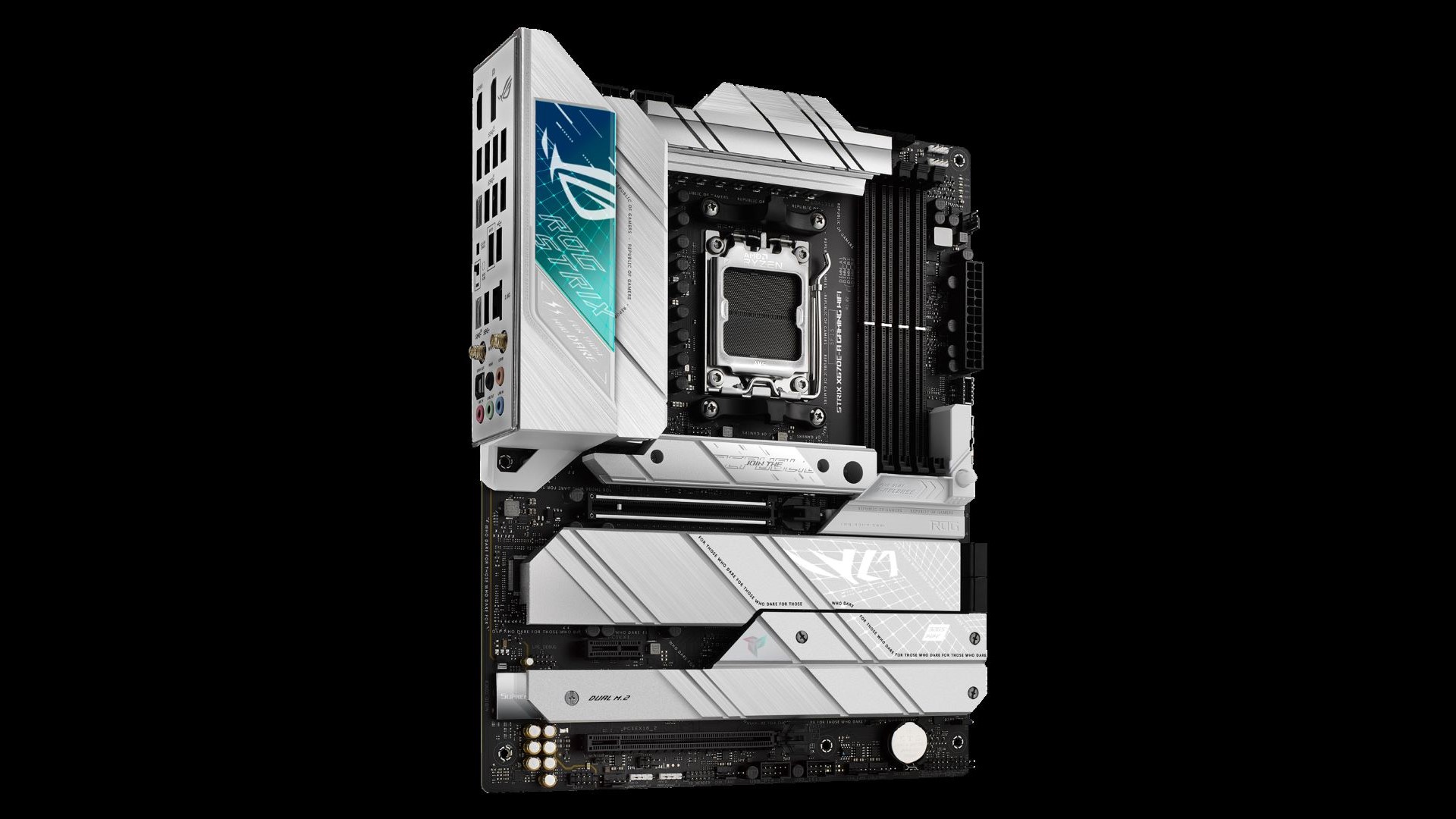
ROG Strix X670E-I Gaming WiFi
The Strix X670E-I might seem impossibly small for what it offers: a complete platform for a next-gen gaming build. It features a PCIe 5.0 x16 slot prepped and ready for a cutting-edge graphics card, a pair of DDR5 DIMM slots, plus two M.2 slots — one wired for PCIe 5.0 and one wired for PCIe 4.0.
Innovative design elements make sure that users get the performance and features they need, even when they are building inside the tight confines of a Mini-ITX case. The I/O shield is pre-mounted for easier installation and a tidier fit around rear ports. A single heatsink cools the PCIe 5.0 M.2 slot and the chipset simultaneously, and VRM temps are aided by a large backplate that leverages a thermal pad to transfer heat away from critical decoupling capacitors. The space-saving ROG FPS-II card provides easy access to front-panel headers, two SATA ports, important headers for clearing CMOS and enabling CPU overvoltage, and a PCIe mode switch for legacy expansion cards.
It is the all-new ROG Strix Hive external control interface that truly sets the ROG Strix X670E-I motherboard apart from the competition. It neatly addresses common challenges that PC builders face when putting together a compact Mini-ITX machine — and it goes a step further by putting motherboard gaming features right at one’s fingertips.
The Mini-ITX form factor does not provide much space for a high-end audio solution, so ASUS (very literally) thought outside the box. The Hive houses top-shelf audio hardware — an ALC4050 codec and an ESS ES9260 Quad DAC, to be precise. A combined audio jack and optical S/PDIF out deliver pristine sound, while an integrated volume knob keeps users in control.
Premium audio is not the only trick up the ROG Strix Hive’s sleeve. It offers a convenient USB Gen 2 Type-C® port that makes it easy to connect external storage and peripherals. It includes the intuitive ASUS Q-LED array so that one can quickly diagnose build problems. An EZ Mode PBO button lets users activate a finely tuned PBO profile in the operating system in real-time — without entering BIOS. And users will even find physical FlexKey and BIOS Flashback buttons as well. Building, updating and troubleshooting a Mini-ITX PC has never been easier.
TUF Gaming Brings Gaming Excellence To Everyone
Many gamers out there have a straightforward shopping list when they are in the market for a new motherboard. They look for products with essential performance, unobtrusive style and reliable operation that is built to go the distance. For these PC builders, ASUS offers the TUF Gaming motherboard family. These boards deliver the performance users need, in designs that communicate durability and practicality.
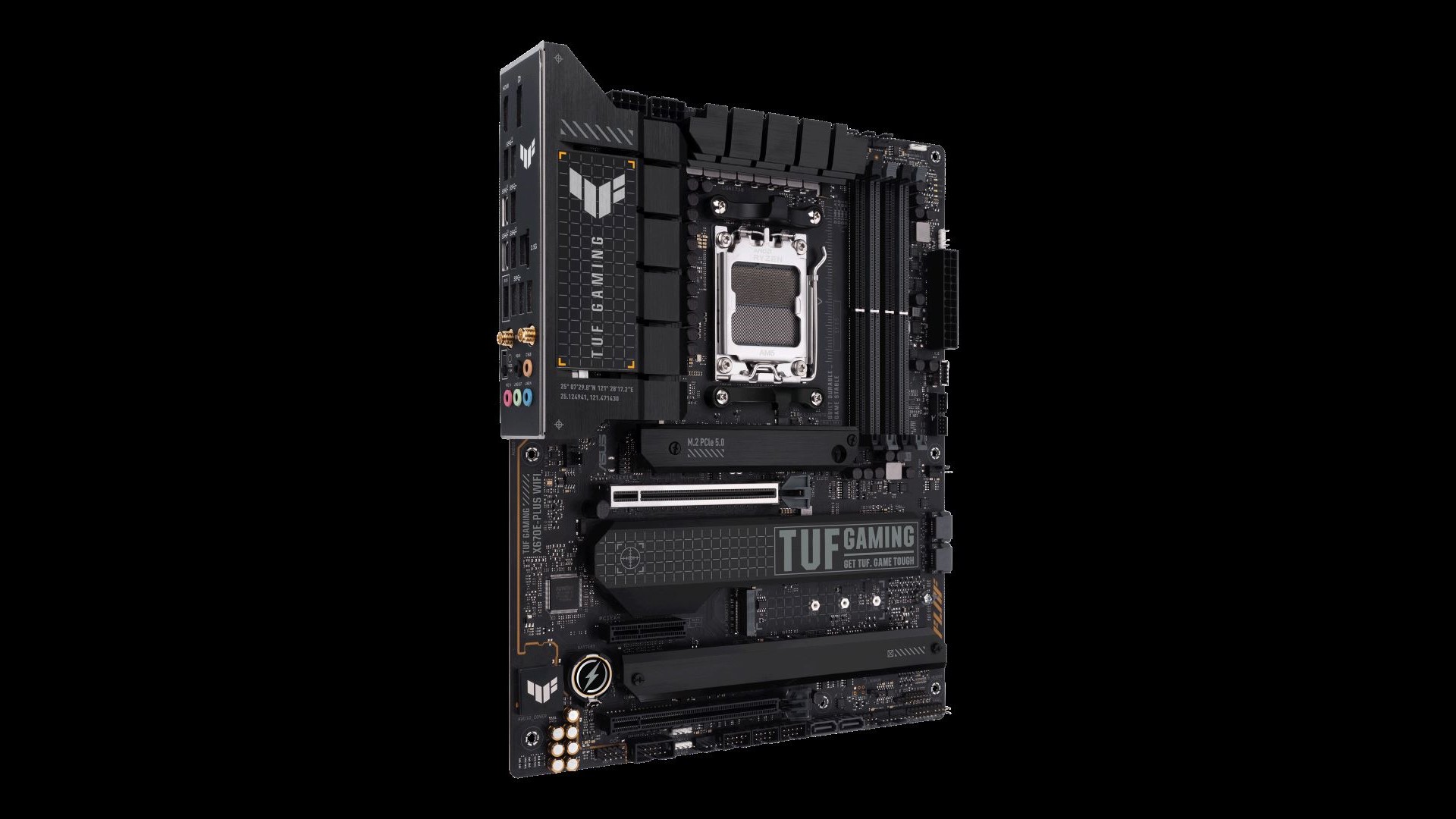
TUF Gaming X670E-Plus and TUF Gaming X670E-Plus WiFi
The TUF Gaming X670E-Plus and TUF Gaming X670E-Plus WiFi motherboards equip users to outpace the competition with their comprehensive feature set and sturdy good looks. Their no-frills aesthetic starts with simple, clean lines and unobtrusive gray hues that make it easy to coordinate the look of a build. Badges on the integrated I/O shield and across the boards provide understated accents.
These motherboards share many of the same next-gen features as the higher-end ROG Crosshair and ROG Strix boards. A PCIe Gen 5.0 x16 slot lets one install the highest-end graphics cards of today and tomorrow. A total of four M.2 slots―one wired for PCIe 5.0, two for PCIe 4.0 and one for PCIe 3.0―let users set up a spacious and speedy storage system. They include a wide array of Q-Design features, including the intuitive Q-LED diagnostic array containing at-a-glance information on the status of a build. If one needs high-performance wireless networking, there is the WiFi 6E-equipped TUF Gaming X670E-Plus WiFi. If a wired connection is all a user needs, the otherwise identical TUF Gaming X670E-Plus will get the job done with its Realtek 2.5 Gbps Ethernet port.
ProArt Flexes Creative Muscles
Gamers assuredly are not the only ones eyeing the performance potential of the latest AMD Ryzen™ 7000 Series processors. Creative professionals like engineers, designers, videographers, animators and game developers all tend to have workflows that can take full advantage of multicore CPUs, high-bandwidth DDR5 RAM and high-speed PCIe 5.0 storage. For these creators and more, ProArt motherboards provide superb connectivity, plentiful high-speed storage options and professional style.
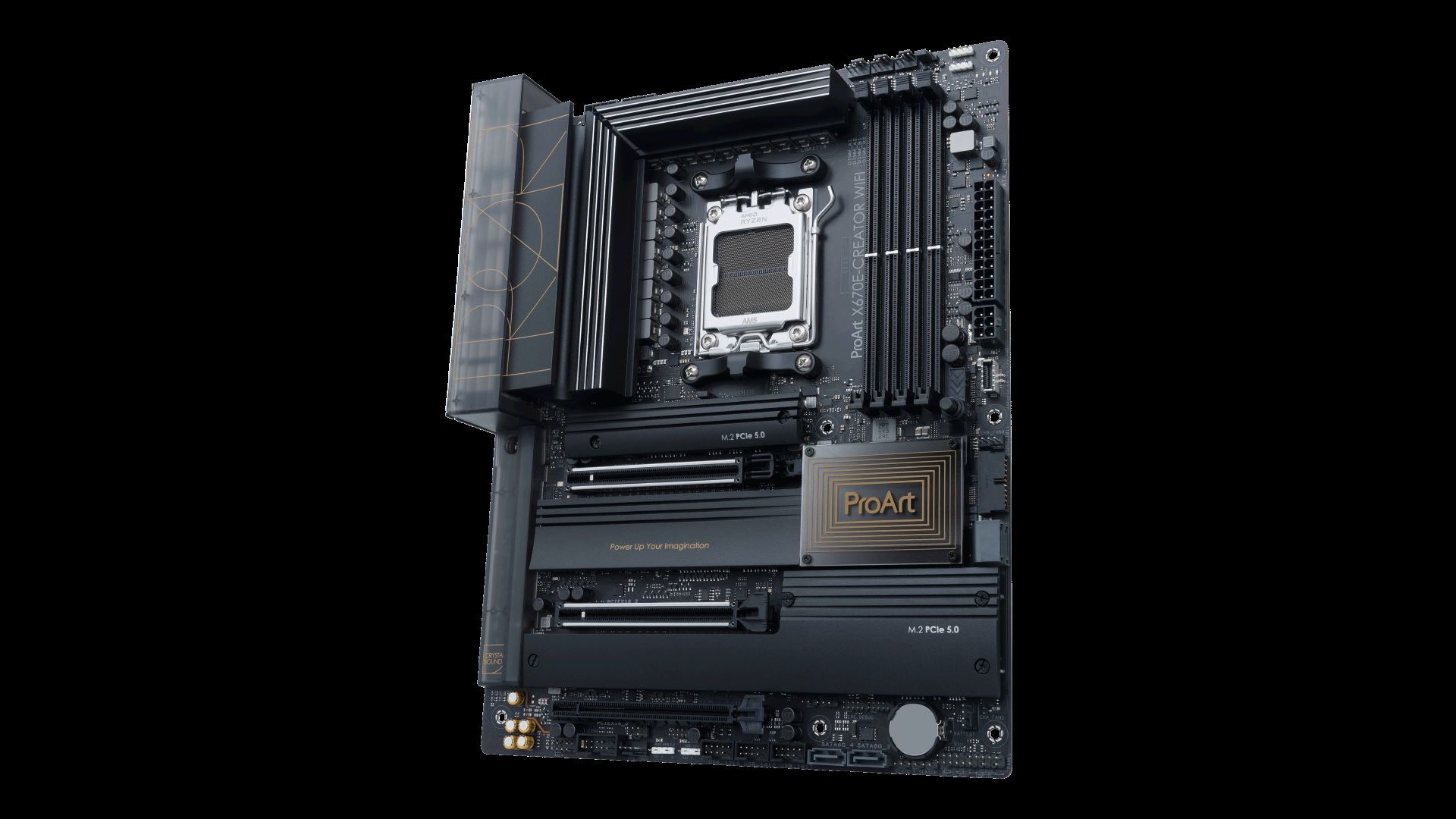
ProArt X670E-Creator WiFi
The ProArt X670E-Creator WiFi ascends to next-gen with an exceptional feature set. It starts with a sophisticated style rooted in clean lines, graceful angles and precise symmetry. Unobtrusive colors give this ProArt board a timeless look that is never out of place, whether building a PC for a home office, the set, or for sharing work with clients. Gold accents on the integrated I/O shield and the chipset heatsink add touches of luxury and refinement.
For creative workflows that scale with high-end memory kits, the ProArt X670E-Creator WiFi will accelerate productivity with the massive bandwidth, lightning-quick speeds and exceptional power efficiency offered by next-generation DDR5 RAM. This motherboard offers a host of hardware and firmware optimizations that enable users to overclock capable kits to the absolute limit.
With PCIe 5.0 connectivity, the ProArt X670E-Creator WiFi gives access to the fastest next-gen SSDs and GPUs. This motherboard boasts not just one, but two PCIe 5.0 x16 slots. Since many creative pursuits take full advantage of the fastest transfer speeds that they can get, ASUS equipped this board with four onboard M.2 slots, two of which are wired for PCIe 5.0.
One will also find a comprehensive selection of high-speed ports designed to connect a full creative workstation. The new PCIe 5.0 protocol provides enough bandwidth to include a pair of USB4 ports on the rear I/O panel. Flexible front-panel connectivity is essential for many workflows, so the ProArt X670E-Creator WiFi offers a front-panel USB 3.2 Gen 2×2 Type-C connector with support for Quick Charge 4+. Combining this with a case that has a front-panel USB Type-C port can grant convenient access to 60W charging.1
Exceptional networking options round out this board’s feature set. With a compatible router, this WiFi 6E radio unlocks access to the previously unused 6 GHz spectrum for stronger wireless connections in select regions. Intel 2.5 Gbps Ethernet provides rock-solid and reliable wired networking, while a Marvell AQtion 10G Ethernet port opens up even more options, such as connecting to blazing-fast network-attached storage.
Get All The Essentials With ASUS Prime Motherboards
For users looking for a straightforward motherboard offering excellent features, reliable performance and unobtrusive design ― all at a good price point ― there is the ASUS Prime lineup.
ASUS is offering a trio of Prime boards for the new AMD X670E and X670 platforms. Atop the stack sits the Prime X670E-Pro WiFi. With its support for DDR5, a PCIe 5.0 x16 slot and a PCIe 5.0 M.2 slot, this is a cost-effective option for anyone building out a next-gen PC. WiFi 6E, a Realtek 2.5 Gbps Ethernet port and a Thunderbolt (USB4) header all add to its already impressive value proposition. And that is before one considers its DIY-friendly feature lineup. Its pre-mounted I/O shield streamlines the installation process, plus it features the PCIe Slot Q-Release button that takes the hassle out of removing a graphics card, as well as a Q-LED diagnostic array that takes the guesswork out of troubleshooting.
The breathtaking transfer speeds offered by PCIe 5.0 SSDs make all the difference in many workloads, but perhaps that is not a must-have feature in the AM5 shopping list of many users. ASUS designed the Prime X670-P WiFi and Prime X670-P for just such users. These boards get the job done with their DDR5 support and offer ample room for storage with their three onboard M.2 slots. A Thunderbolt (USB4) header lets users set up a flexible, high-speed front-panel port in a compatible case. If onboard wireless networking is a must, grab the Prime X670-P WiFi, which offers WiFi 6 connectivity. If one is content with wired networking, opt for the otherwise-identical Prime X670-P.
Complete A Build With ASUS PC DIY Components
ASUS built its reputation on the quality and performance of its motherboard lineup. Today, ASUS offers a wide-ranging product portfolio that includes just about everything needed to build a complete PC — from graphics cards to cases, from case fans to AIO liquid coolers, and from power supplies to graphics card holders. There’s also a complete lineup of displays, peripherals and wireless networking products. ASUS provides everything needed to build a PC with a cohesive, unified aesthetic―a machine that extends the legendary quality of ASUS motherboards to every component, anchored by an ASUS X670E or X670 motherboard that is surrounded by an array of hardware drawn from a vast ecosystem.
Gamers and creators will be looking for a graphics card for their new Ryzen build, and ASUS has a large array of options at the ready. Whether a user needs a cutting-edge graphics card with one of the best GPUs offered by ASUS partners AMD and NVIDIA, or whether a user needs an affordable entry-level model―ASUS has it all. Click here to learn more about their different graphics card offerings.
For help getting started with a first-time build — or perhaps to get inspiration for the next one — head over to the PC DIY portal for insider info on the latest ASUS products, videos breaking down the process of building a PC, and for recommended builds that make it easy to put together a complete shopping list. Assembling a PC is easier than one might think, and ASUS is happy to help builders get started.
[i] For 60W charging, a 6-pin PCIe power cable must be connected to the motherboard.
Availability & Pricing
Model | SRP | Warranty |
| ROG Crosshair X670E Extreme | RM 5,129 | 3 + 1 Year Extended Warranty Register at: https://my.rog.gg/WarrantyExtension |
| ROG Crosshair X670E Hero | RM 3,569 | |
| ROG Crosshair X670E Gene | RM 3,129 | |
| ProArt X670E-Creator WiFi | RM 2,719 | |
| ROG Strix X670-E Gaming | RM 2,729 | |
| ROG Strix X670E-F Gaming | RM 2,279 | |
| ROG Strix X670E-I Gaming | RM 2,409 | |
| TUF Gaming X670E-Plus WiFi | RM 1,789 | |
| Prime X670-P WiFi-CSM | RM 1,559 |
